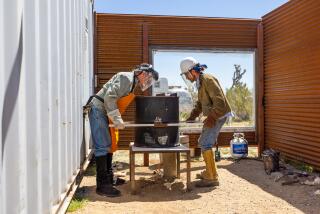Utah University Spurs Creation of ‘Bionic Valley’ : Artificial Body Parts May Aid Thousands
- Share via
SALT LAKE CITY — Here at the foot of the Wasatch Mountains, where research models of mechanical hearts routinely keep sheep and calves alive, people with failed body parts are being fitted with artificial blood vessels, artificial inner ears that restore hearing and artificial arms that are activated by nerve signals from remnant muscles.
Soon perhaps, other man-made body parts under research here will also find their way into daily human use: a Fallopian tube for infertile women, a urinary system, maybe even an artificial hand.
The research on artificial body parts here has made the Salt Lake City area an extraordinary incubator of high technology, whose advances may someday touch and improve the lives of hundreds of thousands of people.
And the effort has given the area a new nickname, modeled after California’s Silicon Valley.
“Salt Lake City is . . . Bionic Valley,” says Science Digest magazine, “the epicenter of a bioengineering effort that promises to shake up the entire health-care system.”
And, said James J. Brophy, the University of Utah’s vice president for research, “It’s just the beginning.”
It was the university that touched it all off 18 years ago, when a handful of officials, described today as visionaries, began recruiting medical and engineering researchers.
“There were some very forward-thinking people here, people who could see further into the crystal ball than others,” said Dr. Donald Olsen, a veterinarian and director of the university’s Artificial Heart Research Laboratory who developed and teaches the surgical techniques for artificial heart implants.
Other researchers and universities across the country are also at work creating artificial organs, but the variety of projects here and the crowning success of the artificial heart developed here are unmatched.
“Collectively, we could see most of this happening,” said James Fletcher, who was university president from 1964 to 1971 and who was instrumental in touching off artificial organ research here before he became administrator of the National Aeronautics and Space Administration.
Pessimistic at First
Although Bionic Valley is widely known as the source of the technology and medical teams that kept Barney Clark alive for 112 days on a Jarvik-7 artificial heart, Fletcher said that originally he had been most pessimistic about work on a heart.
“I was more optimistic about other artificial organs than a heart,” he recalls. “The hearts seemed to be out of line because of the tubes going into the body.”
It was under Fletcher that the university in 1967 recruited Dr. Willem J. Kolff, the inventor of the artificial kidney (now known as the dialysis machine), a driven man and a genius of a gadgeteer.
“He got the engineers and the doctors to work together,” said Dr. Fred Shapiro, president of the American Society for Artificial Internal Organs. “That was his unique contribution.”
Now Nearing Retirement
Kolff, now 74 and nearing retirement, formed the Institute for Biomedical Engineering at the university and taught, recruited and inspired many of the artificial organ researchers. Many were non-medical specialists who worked on perfecting the materials, the microcircuitry and other physical needs of artificial organs.
“Kolff was the catalyst,” Olsen said, “and, once he was here, things started to happen. He came with an artificial heart project and a tremendous career in artificial kidneys and kidney dialysis. Kolff could support the wildest of notions--and many of them have worked. The track record is phenomenal.”
In what has come to be known as “academic capitalism,” the University of Utah encouraged researchers to carry their work through commercial development by forming small businesses to produce and market high-tech medicine, with the state-funded university sharing in the profits.
25 Companies Spun Off
Thus far, 25 start-up companies have been spun off from the university, most of them in biomedical engineering.
“If one of our faculty members is interested in helping create a company to commercialize his research activities, we’ll help,” Brophy said. “It’s great. It creates jobs and tax money. The university has a responsibility to get the benefits of academic research to the public in the most efficient way. And I’m not ashamed to take our part of the action.”
Jarvik-7 Manufacturer
The university, for example, holds an interest in Symbion, the Salt Lake company that manufactures and markets the Jarvik-7 artificial heart.
In the same building as Symbion, Olsen’s artificial heart laboratory is now working on refinements of the mechanical heart that could lead to the day of a completely implanted, electrically powered heart, without tubes stretching from a recipient’s chest to a pneumatic pump. The Utah 100 elliptical heart is also under development, a smaller version of the Jarvik-7 that could significantly increase the number of people eligible for artificial hearts.
Artificial Urinary Tract
The laboratory is also developing:
--An artificial urinary tract. Stimulated by a group of investors--one of whose father suffered bladder cancer--researchers are in the early stages of trying to develop a man-made system of ureters, bladder and urethra.
--Controlling sphincters. These artificial gateways, completely implanted and controlled by electricity, could replace the natural ring-shaped muscles in the digestive and excretory systems.
--A Fallopian tube. Being tested in sheep, the artificial organ could replace malfunctioning Fallopian tubes, the leading cause of female infertility in the United States. If successful, the artificial tubes would capture eggs from the ovaries and a micropump would supply them with nutrients and transport them to the uterus, for natural development into embryos.
Artificial Blood Vessels
Other artificial organ projects here are still closer to reality:
--Artificial blood vessels. Vascular International, a university spinoff company, is conducting clinical trials of artificial blood vessels, some the diameter of a pencil and others smaller than a pencil lead, for use in people whose natural blood vessels, usually in the extremities, have been damaged or become diseased, such as with hardening of the arteries. “There’s no really good synthetic available for the smaller diameters now,” said Don J. Lyman, a polymer chemist and professor in the University of Utah’s Department of Materials Science who estimates that 300,000 to 500,000 people may benefit each year.
--A hearing implant, or artificial ear. A six-channel electrode implant in the cochlea is also undergoing testing in 45 people worldwide who have lost their hearing. Dr. James Parkin, chairman of the university’s department of otolaryngology, said one woman fitted with an Ineraid device is now able to hear melodies and is able to dance to music. About 165,000 deaf people nationwide could benefit.
Artificial Kidney
--A portable artificial kidney. Now being manufactured, a lightweight artificial kidney also developed by the Center for Biomedical Design is giving kidney patients freedom from frequent hospital visits for dialysis.
--An artificial arm. Using advanced electronics, the university’s Center for Biomedical Design has developed an artificial arm that is activated up and down by nerve impulses from remaining tissues in amputees. When an elbow locks, the one-pound hand opens and closes by electric motors, eliminating the traditional cables that have operated hooks or hands. The Utah Arm is being manufactured and marketed under a license arrangement with the university by Motion Control.
The center is also working with the Massachusetts Institute of Technology to develop a mechanical hand designed to do as much as the human hand can. “A simplified version someday could end up in a prosthetic device,” said Barry K. Hanover of the center.
And Olsen talks of future projects that must seem as impractical now as the artificial heart seemed in 1957, when work on it was done in secret, Dr. Kolff recalls, “because nobody believed it.”
“I’ve got some wild ideas,” Olsen said. “Artificial organ ideas always sound so wild--it’s exciting.”






